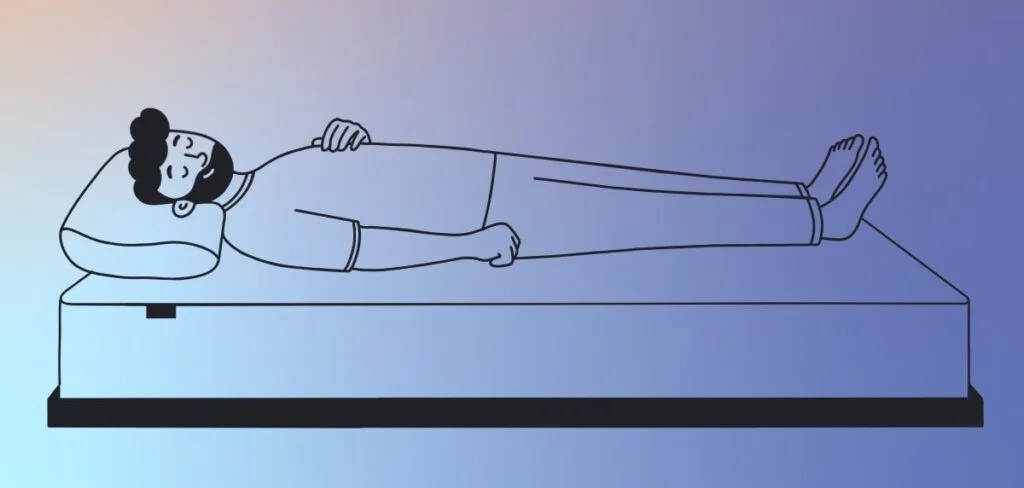
Are you a soldier, yearner, or free faller? Turns out, sleep positions have actual names, and they might say much more about you, your sleep quality, and your health than we knew. A recent survey through OnePoll and Purple Innovation, of over 2,000 participants, showed that only 1 in 10 Americans are waking up feeling refreshed, and that sleep positions might be playing a role.
Those soldier sleepers prefer to rest on their backs, with their arms at their sides. Yearners, on the other hand, are side sleepers with their arms out, and Freefallers are die-hard belly sleepers. But the most common position of all, with nearly half of Americans snoozing this way, is the side sleeper, at 42 percent of participants. In addition, the survey found that around 1 in 5 Americans like to switch up their sleep position nightly, and don’t fall into one category or the other.
But why does it matter? Turns out multiple aspects of your health can be connected back to sleep position, from orthopedic aches and pains to just how restful of a sleep you are getting. Those with Obstructive Sleep Apnea (OSA), are also commonly asked to reconsider or adjust their sleeping position for more optimal breathing in the night.

“There are many caveats because clinical conditions and personal preference will impact the sleep position in which a person feels comfortable,” says Dr. Carleara Weiss, Ph.D., MS, RN, and Sleep Science Advisor for Aeroflow Sleep. “For example, if someone snores, they should sleep on their side. On the other hand, someone with neck and shoulder pain may prefer to sleep on their back or stomach.”
Here’s what you need to know to hack your sleep position strategy to sleep more comfortably.
The most ergonomic sleep positions to try
If your back is aching before your feet even hit the ground in the morning, it might be time to take a second look at your sleep position. In one research report, authors found that symmetrical side lying led to fewer morning symptoms for spinal pain.
“Ergonomically speaking, the two best sleep positions, in general, are side and back sleeping, meaning that side sleeping is optimal, followed by back sleeping,” Weiss says. “These positions — with adequate support from pillows and mattresses that do not overextend their neck, shoulder, and lower back — allow the body to stay closer to a neutral, anatomical position through the night and maximize comfort for excellent sleep quality.”
She adds that when you are awake, think through the potential causes of your uncomfortable sleep environment — it might be time for a new pillow, which she recommends replacing every 1-2 years, or even a new mattress. “Invest in making that adjustment before bedtime to avoid the stress of tossing and turning.”
You might find a pillow between your knees while side sleeping helps alleviate back pain, as it keeps your pelvis and spine aligned, according to Dr. Meeta Singh, a sleep doctor and psychiatrist who consults with college and pro sports teams, as well as C-suite leaders to optimize sleep health. But, if you have hip or shoulder issues, you might want to avoid that position, she adds.
Additional health conditions, and your sleep position
Unfortunately, sleep positions aren’t just about what feels the most comfortable, but also about which is best for your overall health. For example, a recent report on Obstructive Sleep Apnea from the American Academy of Sleep Medicine recognizes sleeping in a supine position (on your back) as a behavioral risk factor for OSA, alongside drinking alcohol before bed, exposure to secondhand smoke, and smoking yourself.

“We know sleeping on the back makes snoring and sleep apnea worse,” Singh says, adding that it can make reflux worse as well.
Other conditions can play a role in your sleep position, such as pregnancy, where belly sleeping becomes essentially out of the question and the left side is often recommended. “The best recommendation is to follow medical advice if you have a medical condition. If you do not have a medical condition, feel free to identify the position that combines comfort and spine alignment (neck, shoulders, lower back), along with pillows and mattresses adjusted to your body weight to ensure a good night of sleep,” Weiss says. In the sleep position study, over half of participants had attempted to change their position due to pain, including back, neck, and shoulder pain.
When sleep position changes aren’t helping
Research shows we shift and change position in our beds 11-13 times per night. If experimenting with alternative positions isn’t helping you sleep better, longer, and with less pain, you can try other techniques. She recommends trying the following.
- Make sure the bedroom is conducive to sleep by maintaining a cool, dark, and quiet environment..
- Establish a bedtime routine: reading, taking a warm bath, or practicing relaxation techniques, can help the body and mind prepare for sleep, making it easier to find a comfortable position.
- Limit caffeine and alcohol
- Exercise regularly
- Manage stress: Stress and anxiety can lead to restlessness and difficulty finding a comfortable sleep position.
In addition, she adds that decreased sleep quality heightens sensitivity to pain, making the sleepless nights/pain problem a vicious cycle. By managing conditions during the daytime, alongside your medical team, you might be able to do more than changing sleep positions can alone.
Sources
McNally, Victoria. “2 in 3 consider themselves anxious sleepers,” March 15, 2024: https://swnsdigital.com/us/2023/03/2-in-3-consider-themselves-anxious-sleepers/
Weiss, Dr. Carleara, Ph.D., MS, RN: Author interview, April 2024.
Dr. Meeta Singh: Author interview, April 2024
Indira Gurubhagavatula, MD, MPH | Cristina Baldassari, MD | Aneesa Das, MD
Michael A. Edwards, MD, FACS | Monica Mallampalli, Ph.D | Diego R. Mazzotti, Ph.D
Imran Patel, DMD | Freda Patterson, Ph.D | John Park, MD, “Obstructive Sleep Apnea
Indicator Report,” American Academy of Sleep Medicine: https://sleepeducation.org/wp-content/uploads/2023/03/obstructive-sleep-apnea-indicator-report.pdf.Gordon SJ, Grimmer KA, Trott P. Self-Reported Versus Recorded Sleep Position: An Observational Study. The Internet Journal of Allied Health Sciences and Practice. 2004 Jan 01;2(1), Article 7.

























